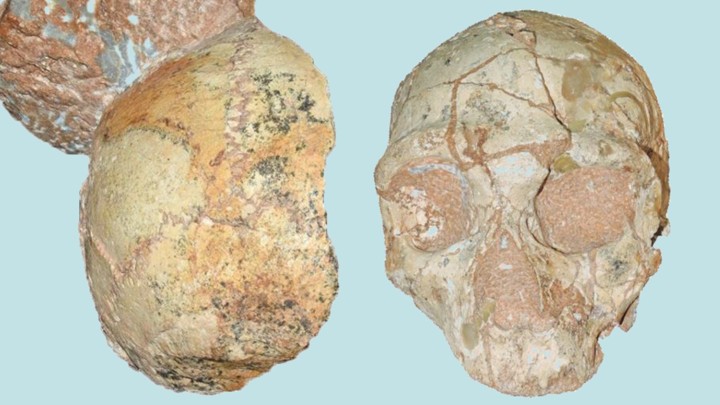A 210,000-year-old skull is the oldest Homo sapiens fossil found outside Africa.
JUL 10, 2019

Apidima 1 (left) is a modern human; Apidima 2 (right) is a Neanderthal.KATERINA HARVATI / EBERHARD KARLS UNIVERSITY OF TÜBINGEN
In 1978, in a cave called Apidima at the southern end of Greece, a group of anthropologists found a pair of human-like skulls. One had a face, but was badly distorted; the other was just the left half of a braincase. Researchers guessed that they might be Neanderthals, or perhaps another ancient hominin. And since they were entombed together, in a block of stone no bigger than a microwave, “it was always assumed that they were the same [species] and came from the same time period,” says Katerina Harvati from Eberhard Karls University of Tübingen.
That’s wrong. By thoroughly analyzing both skulls using modern techniques, Harvati and her colleagues have shown that they are very different, in both age and identity.
The one with the face, known as Apidima 2, is a 170,000-year-old Neanderthal—no surprises there. But the other, Apidima 1, was one of us—a 210,000-year-old modern human. And if the team is right about that, the partial skull is the oldest specimen of Homo sapiens outside Africa, handily beating the previous record holder, a jawbone from Israel’s Misliya Cave that’s about 180,000 years old. “I couldn’t believe it at first,” Harvati says, “but all the analyses we conducted gave the same result.”
Until now, most researchers have focused on the more complete (but less interesting) of the two skulls. “Apidima 1 has just been ignored,” says Harvati. But its antiquity matters for three reasons. First, it pushes back the known presence of modern humans outside Africa by some 30,000 years. Second, it’s considerably older than all other Homo sapiens fossils from Europe, all of which are 40,000 years old or younger. Third, it’s older than the Neanderthal skull next to it.
Collectively, these traits mess up the standard story of Neanderthal and modern-human evolution. According to that narrative, Neanderthals slowly evolved in Europe, largely isolated from other kinds of hominins. When modern humans expanded out of Africa, their movements into Europe might have been stalled by the presence of the already successful Neanderthals. That explains why Homo sapiens stuck to a more southerly route into Asia, and why they left no European fossils until about 40,000 years ago. “The idea of Europe as ‘fortress Neanderthal’ has been gaining ground,” says Rebecca Wragg Sykes, an archaeologist from the University of Bordeaux, but identifying a 210,000-year-old Homo sapiens skull from Europe “really undermines that.”
“It suggests that early Homo sapiens groups got farther than we may have previously thought, occasionally occupying territories that later became that of Neanderthals,” adds Shara Bailey, an anthropologist at NYU. “Findings like this are very important for informing us on the evolution of our species.”
The identity of Apidima 1 could also cast doubt on other archaeological finds from Europe, such as stone tools with no accompanying fossils. Researchers had long assumed that within a certain time window, “any archaeology was all the work of Neanderthals,” says Wragg Sykes. But if modern humans also occupied this “safe range,” which species actually created those artifacts?
These interpretations depend on the dating of the Apidima skulls, which has always been difficult. They were found in an odd place—a small niche near the cave ceiling, separated from any sediments that could have been easily dated. They were also entombed in breccia, a composite rock made from fragments that have been cemented together. It seems that, as ice ages came and went and sea levels rose and fell, parts of the cave’s interior were flooded and eroded, and both skulls were dislodged from their original resting places. They fell into a cavity and got stuck.
Harvati’s team estimated their ages by analyzing the minute amounts of uranium within them. They then scanned both skulls, reconstructed what they would have looked like before being broken and distorted, and compared their three-dimensional shapes with those of other hominins. In that comparison, Apidima 2 clearly clustered with Neanderthals, while Apidima 1 grouped with skulls from modern humans.
How much information can scientists really glean from just the back of the skull, and just the left half at that? Actually, quite a lot, Harvati says: That region is very informative when telling different hominins apart. Apidima 1 lacks several traits that are distinctively Neanderthal, while its rounded shape “is considered to be a uniquely modern human feature that evolved relatively late,” Harvati says.
But “it doesn’t look like classic Homo sapiens,” says Wragg Sykes, who wonders whether it represents a group of humans that had been interbreeding with Neanderthals or other ancient hominins. “Obviously everyone is going to want to see DNA out of that skull,” she adds.
The team’s analysis “is convincing,” and its study is one of several that have recently shaken our understanding of human evolution, says Mina Weinstein-Evron from the University of Haifa. Finds like 300,000-year-old bones from Jebel Irhoud in Morocco suggest that our species arose from several diverse populations that lived across Africa. Meanwhile, bones from Misliya and Apidima tell us that early humans then expanded into other continents, and interacted with other hominins, far earlier than previously thought.
The Apidima skulls also suggest that the accepted story of Europe, in which modern humans eventually replaced the long-dominant Neanderthals, is too simple. Instead, Harvati thinks that modern humans were already in Greece about 200,000 years ago; they were then replaced by Neanderthals, who were themselves replaced by humans about 40,000 years ago. A similar cycle of competition, where Neanderthals and humans repeatedly replaced each other, seems to have happened in the Levant, the Middle Eastern region that includes Israel and Syria. “We can’t refer to Homo sapiens as a ‘success’ in terms of being able to move into new areas and stay there,” Wragg Sykes says.
Of course, it’s possible that both hominins just lived together. But genetic studies suggest that while they did intermittently meet and mate, the groups weren’t in constant contact. “I don’t think they coexisted,” says Harvati. “But maybe I’m wrong. We don’t have the evidence one way or the other, and we need to look for more.”
Greece is a good place to start. “It’s at the crossroads of three major continents, and it’s a refuge where animals and humans could survive at the height of the ice ages,” Harvati says. “You’d predict population dispersals and range contractions in these areas, the possibility for contact [between different groups], and a more diverse human-fossil record than you’d find in distant parts of Europe. There aren’t many fossils in the region, but it hasn’t been much of a research priority.”
The Apidima skulls “illustrate that there is much to learn in areas outside of western Europe and the Levant, where most of our research has concentrated,” says Bailey. “We may find the first anatomically modern humans lacked the kind of advantages that later Homo sapiens may have had”—the very same advantages, she says, that led to our “ultimate domination.”
We want to hear what you think about this article. Submit a letter to the editor or write to letters@theatlantic.com.
ED YONG is a staff writer at The Atlantic, where he covers science.












Đăng nhận xét